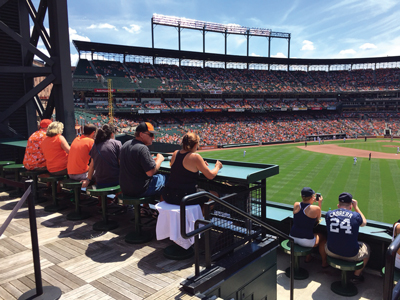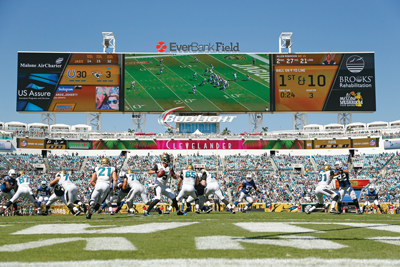Thomas Scarangello, Thornton Tomasetti: “Virtual design and construction has dramatically altered the landscape. We now have the tools to collaborate at every stage of design and construction, which has blurred, and in many cases erased, barriers between design and construction.”
Dan Meis, Meis Architects: “Temporary seating infrastructure. I believe the age of the $1 billion stadium is not sustainable. We are exploring several ways of utilizing temporary architecture and systems to reduce the initial cost of the facility and significantly improve flexibility over the life of the venue.”
Jack Hill, San Francisco 49ers: “The incorporation of various new technologies in the design, construction and operation of sports facilities and how these new technologies enhance the fan experience.”
Troy Hoberg, Hunt Construction: “One trend is taking seat count down in MLB and making more club space and
 |
Social gathering places such as the center-field rooftop deck at Oriole Park continue to spread throughout facilities.
Photo by: Don Muret / Staff |
night club intrusion into the venues.”
Gerardo Prado, HNTB: “The next generation of sports facility will provide more diversification of amenities inside and outside the venue, catering to fans of all ages and backgrounds, not just the premium-seat customer. … Venues will continue to increase the number of uniquely branded concourses, seating zones, plazas, clubs and social zones to better connect with fans and cultivate the future generation of sports fans.”
Earl Santee, Populous: “We are living in a time when the market is demanding that stadiums reduce their seating capacities because more people are watching the event on their television. Thus, we are having to reduce the number of seats in stadium bowls allowing for a more intimate live experience.”
Mitchell Ziets, Tipping Point Sports: “(A) Utilizing sports facilities as catalysts for real estate development as a means to derive additional value beyond the venue, especially in light of limited public resources and (B) Activating venues with new programming — e-sports, fantasy dedicated spaces, event plazas, amphitheaters, festivals and club spaces.”
Paul Griesemer, HNTB: “Extending the game-day experience with adjacent entertainment opportunities continues to expand projects to surrounding development and other ancillary mixed-use developments. This has led to sports teams and developers working closely with architects and planners in master planning beyond the walls of the venues, to the surrounding properties that can support ancillary development, increase revenues and improve the experience for everyone.”
David Manica, Manica Architecture: “The merging of other building types into the stadium. For example, our Moscow project combines an outdoor stadium, and indoor arena, and a retail mall. Our project in San Diego has been dubbed ‘the convadium’ because it merges a bespoke convention center expansion into a fully operational NFL stadium.”
Sherri Privitera, Populous: “One trend that is resurfacing but perhaps in a different way is envisioning ways to utilize sports venues year-round beyond the sport they are designed for. Stadiums, especially on campuses, are integrating academics, year-round dining, membership clubs and community activities.”
Randy Shelly, Shawmut Design and Construction: “The ‘pop-up’ concept, converting underutilized space into revenue-producing attractions, is one trend we’re watching, and participating in. We recently completed the new Clippers Courtside Club at the Staples Center and the big appeal, from an owner’s standpoint, is the ability to quickly set up the club before games and dismantle it quickly after.”
Tom Proebstle, Generator Studio: “One-hundred percent privately financed new (or renovated) venues versus existing venues needing public support to maintain viability.”
Jim Renne, Rossetti: “Across most major league sports, total seating capacity is reducing. While this has been projected, venues are actively seeking to right-size to actual demand for in-venue consumption of sports and entertainment by analyzing the real estate to create alternative fan experiences.”
Don Dethlefs, Sink Combs Dethlefs: “At all levels more premium/individualized experiences. More areas for each individual to select from depending on their focus. Emerging technologies and their potential revenue streams continue to influence the spectator experience, even on midsize venues.”
 |
Much of the efforts to improve the fan experience includes technology such as the giant videoboard at EverBank Field.
Photo by: Getty Images |
Nate Appleman, HOK: “Student-athlete welfare has become a major point of emphasis within collegiate athletics. To that end, design and construction of training facilities has been a significant driver within the industry.”
Dale Koger, Legends Project Development: “New design concepts and amenity offerings being implemented to attract millennials to venues and sporting events. This is obviously a balancing act between social gathering spaces and affordability versus maximizing the highest-priced inventory and overall venue capacity.”
Tom Tingle, Skanska: “Existing stadiums and arenas are recalibrating their mix of premium amenities. The reduced interest in luxury suites has allowed owners to create unique opportunities for new locations of club seats and loge boxes with exclusive club spaces.”
Kacie Renc, JMI Sports: “There is an increased focus on athlete performance resulting in massive team campuses to accommodate not only trainers, nutritionists and masseuses but now also team acupuncturists and private chefs. Walk-in cryogenic freezers for muscle recovery and anti-gravity treadmills for maximizing workouts are becoming the norm. Are visiting team campuses next?”
Brad Schrock, HOK: “Ultra-sustainable solutions. Sports teams are just now beginning to scratch the surface on what a truly environmentally sensitive building might look like. Sports facilities that are truly woven into their urban environments and encourage mixed-use development, walkability, facilitate connections to public transit and encourage activity 365 days a year are the framework for sustainable solutions.”
Scott Radecic, Populous: “I am watching the changing desire of fans and spectators who want a more social game and event experience. … We have to now keep in mind that spectators want to spend less time in their seats, but still be physically and visually connected to the game. It also requires us considering social media’s part in the fan experience.”
Dan Barrett, Barrett Sports Group: “One of the major trends in sports facility design and construction is the broadening scope of the fan experience and engagement at live sporting events. Constantly evolving expectations of fans will continue to force sports facility owners, operators and designers to improve the fan experience, from
arrival to departure.
Ron Turner, Gensler: “The evolution of how fan information is harvested is one to watch. Geofence technology that collects all the social media generated inside a venue can be monitored to understand what the fans are most interested in and then used to shape a better fan experience.”
Derek Cunz, Mortenson Construction: “Technology. While there is a lot of discussion about the ‘internet of things’ at the consumer level, the revolution of connectivity and data analytics within sports venues is just beginning.”
Bob Hart, Hunt Construction: “The audio, visual, control and information technology systems continue to expand throughout facilities, incorporating the latest developments in multimedia, advertising and building automation.”





